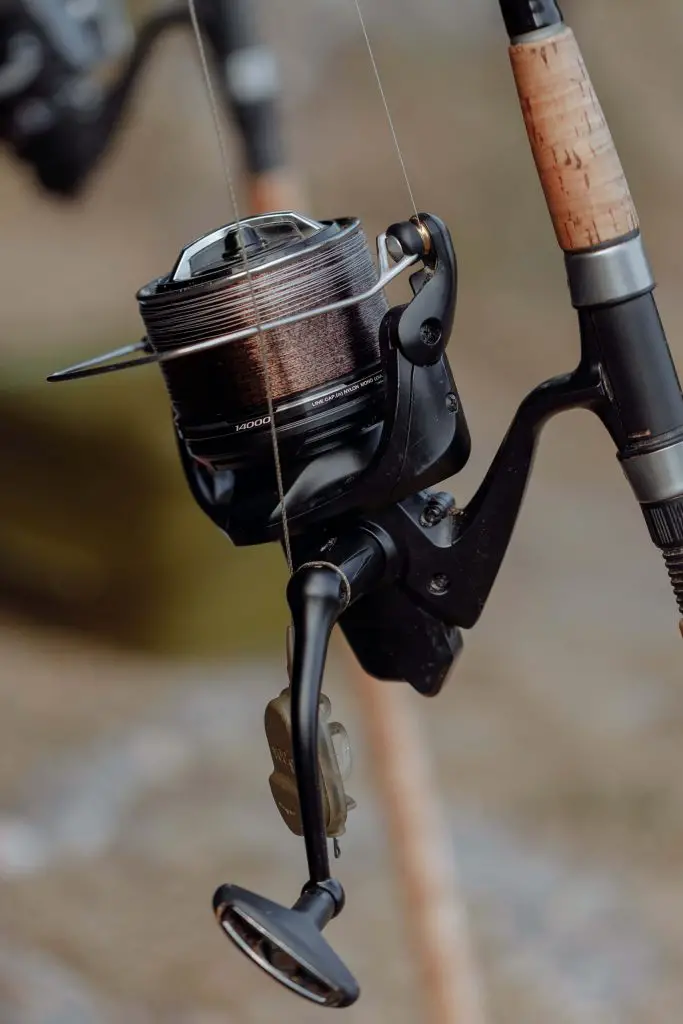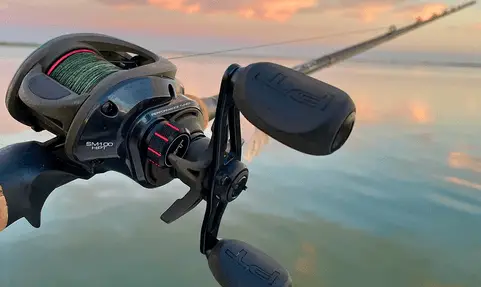To use a baitcaster reel, adjust the brake system and spool tension, hold the rod at a 45-degree angle, engage the reel, and release your thumb from the spool while casting. Mastering the art of using a baitcaster reel takes practice and patience, but with the right technique, you can achieve accurate and controlled casts.
Baitcaster reels offer anglers unmatched casting distance and precision, making them popular among experienced fishermen. However, if you’re new to baitcasters, getting started might seem daunting. In this guide, we’ll walk you through the basics of using a baitcaster reel, helping you become a more skilled angler.
Learn how to set up, cast, and handle these versatile reels for a successful fishing experience.
When it comes to choosing the right baitcaster reel, it’s important to consider several key factors that will affect your fishing experience. Understanding the gear ratio, braking systems, and evaluating the reel’s construction and materials are all essential in making an informed decision. Let’s dive into these aspects to help you make the right choice for your fishing needs.
What is a baitcaster reel
A baitcaster reel is a type of fishing reel with a spool that rotates perpendicular to the fishing rod. It requires manual control of line release using the angler’s thumb and often includes braking systems to prevent backlash. Known for their strength and versatility, baitcaster reels are favored by experienced anglers for their casting accuracy and ability to handle heavier lines and lures.
Understanding Gear Ratio
The gear ratio of a baitcaster reel refers to the number of times the spool rotates for each turn of the handle. It plays a crucial role in determining how quickly you can retrieve your bait and how much power you can exert when reeling in a catch. A higher gear ratio, such as 7.0:1 or 8.0:1, means the spool will rotate more times per handle turn, resulting in a faster retrieval speed. On the other hand, a lower gear ratio, like 5.1:1 or 6.3:1, provides more power but at a slower retrieve rate. Consider the type of fishing you’ll be doing and the specific techniques you’ll employ, as different gear ratios are better suited for different fishing styles.
Considerations For Braking Systems
The braking system of a baitcaster reel controls the rotation of the spool during casting, preventing backlash and allowing for smoother, more controlled casts. There are two main types of braking systems to consider: magnetic and centrifugal. Magnetic braking systems use magnets to regulate the speed of the spool, while centrifugal systems utilize adjustable brake pins or weights. Both systems have their own advantages and disadvantages, so it’s important to choose one that matches your casting style and skill level. If you’re a beginner or prefer a more forgiving reel, a magnetic braking system may be more suitable. For experienced anglers who appreciate more precise control, a centrifugal system might be the better choice.
Evaluating The Reel’s Construction And Materials
The construction and materials of a baitcaster reel can greatly affect its durability, smoothness, and overall performance. Pay attention to the body material, as high-quality reels often feature lightweight yet sturdy materials like aluminum or graphite. Aluminum frames offer excellent strength and rigidity, while graphite frames provide a lighter weight option. Additionally, consider the quality of the reel’s bearings, as more bearings typically result in smoother operation. Look for corrosion-resistant stainless steel or ceramic bearings to ensure longevity, especially if you plan to fish in saltwater environments. Finally, check the quality of the drag system, as a smooth and reliable drag is essential for fighting and landing fish of varying sizes. 
Using a baitcaster reel can be intimidating for beginners, but with the right knowledge and practice, it can greatly enhance your fishing experience. One crucial aspect of utilizing a baitcaster reel effectively is setting it up correctly and making necessary adjustments. In this section, we will guide you through the process step by step, ensuring that you have a smooth and successful fishing expedition.
Spooling The Line
Before you can start fishing with a baitcaster reel, you need to properly spool the fishing line. Here’s how you do it:
- Begin by attaching the reel to the rod. Ensure that the reel seat is secured tightly to prevent any movements during casting and retrieving.
- Next, locate the line guide on the reel, which is the small oval-shaped opening through which the line will pass.
- Take the end of your fishing line and thread it through the line guide. Make sure the line is inserted from the bottom up, ensuring a smooth flow while casting.
- Once the line is threaded, secure it to the spool with an arbor knot. This knot works by wrapping the line around the spool and tying a secure knot. Trim any excess line.
- Now, manually rotate the spool clockwise to ensure the line is securely wrapped around it. Take caution not to create any tangles while doing this.
- Lastly, close the reel’s bail arm and give the line a gentle tug to ensure it is properly secured and won’t slip during your fishing expedition.
Adjusting The Drag
The drag system on a baitcaster reel is crucial for controlling the amount of resistance the fish encounters when pulling on the line. To adjust the drag:
- Locate the drag adjustment knob on the reel, typically found on the side or front.
- When starting, set the drag to a lower setting to provide some flexibility and prevent your line from breaking while fighting a fish.
- If your drag system has numbers, start with a low setting such as 2 or 3. If it uses a dial or a star-shaped knob, rotate it counterclockwise to loosen the drag.
- To fine-tune the drag, test it by pulling the line with your hand. You should feel a slight resistance without the line being too loose or too tight.
- Repeat this process until you find the optimal drag setting for the type of fish you are targeting.
Fine-tuning The Braking System
The braking system on a baitcaster reel helps prevent backlash and provides better control during the cast. Here’s how to fine-tune it:
- Locate the brake adjustment dial, which is usually located on the side plate or the palm side of the reel.
- Begin by setting the brake to the maximum or the highest setting. This will enable you to gain better control over the reel during practice.
- As you become more comfortable and proficient with casting, gradually reduce the braking system’s intensity by adjusting the dial or the sliding mechanism.
- Continue adjusting until you find the appropriate brake setting that allows for longer casts without causing backlash.
With these steps, you can properly set up and adjust your baitcaster reel to optimize your fishing performance. Remember, practice makes perfect, so take the time to hone your skills and gain confidence with your reel. Happy fishing!
Casting with a baitcaster reel can be a bit intimidating for beginners, but with practice and the right technique, you can become a pro in no time. In this section, we will explore the essential aspects of mastering the casting technique with a baitcaster reel. From gripping the reel and rod to executing the cast with proper thumb control, we will cover it all. So, let’s dive right in!
Gripping The Reel And Rod
Before you start casting with a baitcaster reel, it’s crucial to have the correct grip on both the reel and the rod. The proper grip not only ensures comfort and control but also reduces the chances of fatigue during long fishing sessions. Here’s how you can grip the reel and rod:
- Hold the reel with your dominant hand so that your fingers wrap around the reel’s handle.
- Rest your thumb on the spool tension knob, which allows you to adjust the tension on the reel.
- Place your other hand on the rod’s handle, positioning your fingers comfortably around it.
- Ensure that your grip is neither too tight nor too loose, as it can affect your casting accuracy and control.
Proper Thumb Control
Thumb control plays a crucial role in mastering the casting technique with a baitcaster reel. It helps in controlling the spool during the cast and prevents backlash, which can be frustrating and time-consuming to untangle. Here are some tips for maintaining proper thumb control:
- Rest your thumb lightly on the spool, applying just enough pressure to keep the line from slipping.
- As you prepare to cast, adjust the tension on the spool using the spool tension knob to prevent the lure from falling too quickly or too slowly.
- During the cast, keep your thumb in contact with the spool, ready to apply more pressure or release it if needed.
Executing The Cast
Now that you have a firm grip and proper thumb control, it’s time to execute the cast with precision. A smooth and controlled cast ensures accurate bait placement and improves your chances of a successful catch. Follow these steps to execute the cast effectively:
- Position yourself with your target area in mind, making sure there is ample space behind you for the backcast.
- Hold the rod at a slight angle with the baitcaster reel facing upward.
- Press the spool release button with your thumb to disengage the spool, allowing the line to flow freely.
- With a smooth and controlled motion, swing the rod backward, loading it with energy.
- Just before the rod reaches its maximum backward position, begin moving it forward in a fluid motion.
- At the desired point in the forward motion, engage your thumb lightly on the spool to slow down the lure and prevent backlash.
- Continue the follow-through motion, allowing the lure to propel towards your target.
Remember, practice makes perfect. With each cast, focus on improving your technique and maintaining consistency. The more you practice, the better you’ll get at mastering the casting technique!
When it comes to using a baitcaster reel, it’s essential to know the common mistakes and troubleshooting techniques to ensure a smooth fishing experience. Whether you’re a beginner or a seasoned angler, understanding these challenges can help you avoid frustration and enhance your fishing skills.
Bird’s Nest Tangles
One of the most frustrating issues anglers face with baitcaster reels is the dreaded bird’s nest tangle. This happens when the fishing line gets tangled and leads to a mess of twisted loops on the spool. To prevent this problem, here are a few techniques you should keep in mind:
- Adjust the brakes and spool tension correctly: When you use a baitcaster reel, it’s crucial to set the brakes and spool tension according to the weight of your lure and the line you’re using. Setting the drag too high or too low can result in bird’s nest tangles. Take the time to understand your reel’s settings and make the necessary adjustments.
- Practice proper casting technique: An erratic or forceful casting technique can contribute to bird’s nest tangles. Make sure to use a smooth and controlled motion when casting, allowing the line to spool off the reel evenly. Avoid sudden stops or jerky movements, as they can lead to tangles.
- Use quality fishing line: Choosing the right fishing line is essential to prevent tangles. Low-quality line is more prone to tangling and can cause frustration on the water. Opt for a high-quality, low-memory line that is specifically designed for baitcaster reels.
Backlash Prevention Techniques
Backlashes are another common issue that can occur when using a baitcaster reel. Backlashes happen when the spool rotates faster than the line exits the reel, resulting in a snarl of tangled line. To prevent backlashes, utilize the following techniques:
- Thumb control: Having proper thumb control plays a crucial role in preventing backlashes. By placing your thumb lightly on the spool during the cast, you can apply gentle pressure to slow down the spool’s rotation and prevent line overruns.
- Utilize the reel’s brakes: Most baitcaster reels come equipped with brakes that help control the spool’s rotation. Adjust the brakes to match the weight of your lure and the casting distance you desire. Increasing the braking system’s strength can help prevent backlashes, especially when you’re using a heavier lure.
- Practice your casting technique: Similar to bird’s nest tangles, a smooth and controlled casting technique is vital to prevent backlashes. Focus on developing a casting motion that allows the line to flow off the spool steadily, avoiding sudden stops that can lead to overruns.
Reel Maintenance And Troubleshooting
Maintaining and troubleshooting your baitcaster reel can go a long way in preventing common issues and ensuring proper functionality. Here are a few maintenance tips to keep your reel in top shape:
| Reel Maintenance Tips | Troubleshooting Techniques |
|---|---|
| Clean and lubricate the reel regularly to prevent dirt and debris from impacting its performance. | If your reel feels gritty or rough, it may be time for a cleaning or lubrication. Disassemble the reel according to the manufacturer’s instructions, clean each part carefully, and apply lubricant where necessary. |
| Inspect the line guide and remove any tangles or debris that may interfere with smooth line movement. | If the line guide is damaged or bent, it can cause issues with line flow. Replace the line guide if necessary, ensuring it is aligned correctly. |
| Check the drag system regularly to ensure it is functioning correctly. | If you experience issues with the reel’s drag, check for any loose or worn drag washers. Replace them if needed and make sure they are properly lubricated. |
By following these common mistake prevention techniques and troubleshooting tips, you’ll be able to make the most out of your baitcaster reel. Remember to practice and remain patient, as mastering a baitcaster reel may take some time. Tight lines and happy fishing!
Conclusion
So there you have it, a comprehensive guide on how to use a baitcaster reel. By following these steps and practicing, you’ll be able to master this fishing gear in no time. Remember to adjust the settings, practice your thumb control, and be patient with yourself as you learn.
Soon enough, you’ll be reeling in those big catches like a pro angler. Happy fishing!

